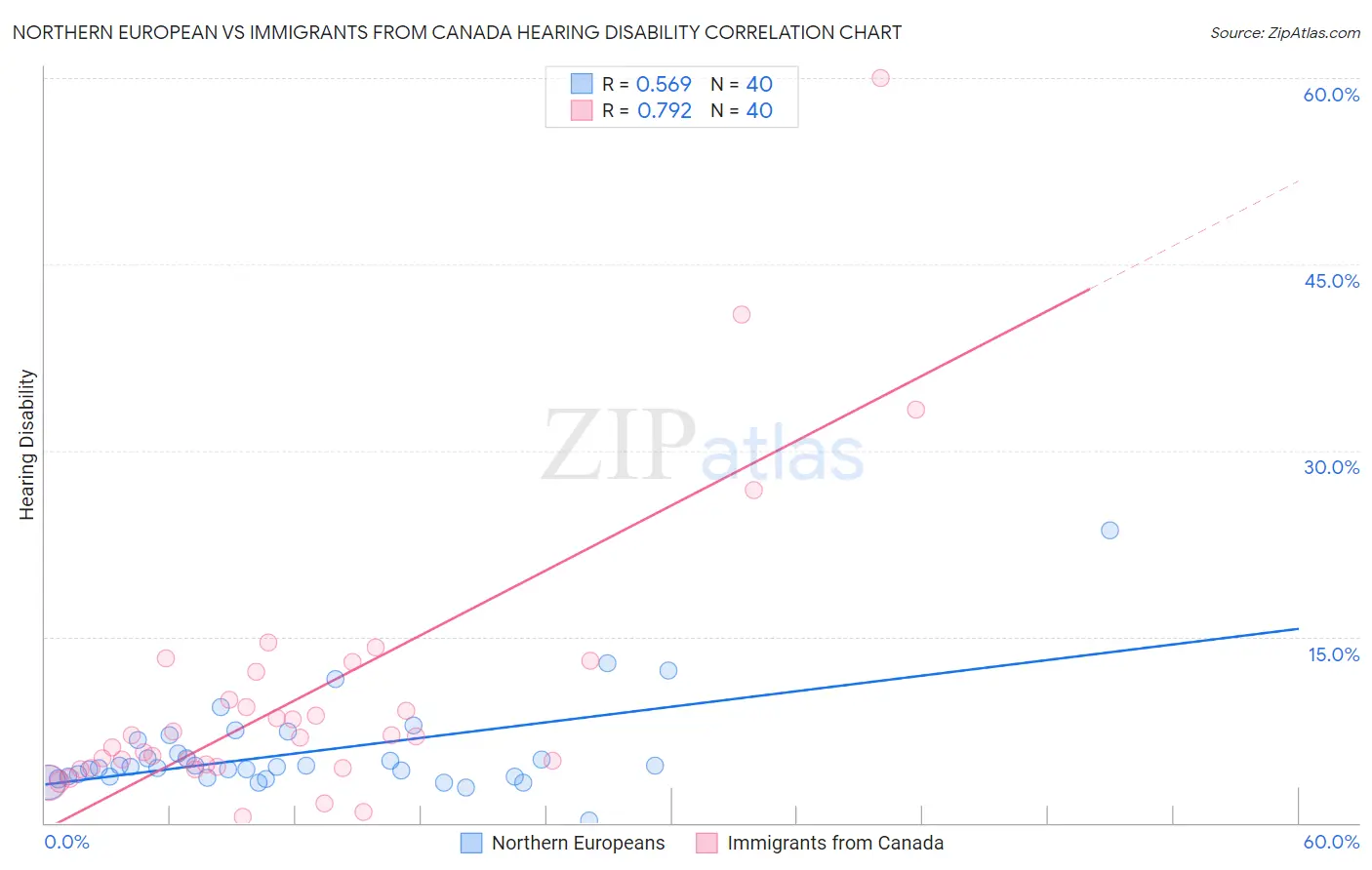Northern European vs Immigrants from Canada Hearing Disability
COMPARE
Northern European
Immigrants from Canada
Hearing Disability
Hearing Disability Comparison
Northern Europeans
Immigrants from Canada
3.4%
HEARING DISABILITY
0.2/ 100
METRIC RATING
258th/ 347
METRIC RANK
3.5%
HEARING DISABILITY
0.1/ 100
METRIC RATING
263rd/ 347
METRIC RANK
Northern European vs Immigrants from Canada Hearing Disability Correlation Chart
The statistical analysis conducted on geographies consisting of 405,970,719 people shows a substantial positive correlation between the proportion of Northern Europeans and percentage of population with hearing disability in the United States with a correlation coefficient (R) of 0.569 and weighted average of 3.4%. Similarly, the statistical analysis conducted on geographies consisting of 459,215,388 people shows a strong positive correlation between the proportion of Immigrants from Canada and percentage of population with hearing disability in the United States with a correlation coefficient (R) of 0.792 and weighted average of 3.5%, a difference of 0.51%.

Hearing Disability Correlation Summary
| Measurement | Northern European | Immigrants from Canada |
| Minimum | 0.22% | 0.49% |
| Maximum | 23.6% | 60.0% |
| Range | 23.4% | 59.5% |
| Mean | 5.7% | 10.2% |
| Median | 4.5% | 7.0% |
| Interquartile 25% (IQ1) | 3.7% | 4.5% |
| Interquartile 75% (IQ3) | 6.2% | 11.0% |
| Interquartile Range (IQR) | 2.4% | 6.6% |
| Standard Deviation (Sample) | 3.9% | 11.5% |
| Standard Deviation (Population) | 3.8% | 11.3% |
Demographics Similar to Northern Europeans and Immigrants from Canada by Hearing Disability
In terms of hearing disability, the demographic groups most similar to Northern Europeans are Yaqui (3.4%, a difference of 0.070%), Slovene (3.5%, a difference of 0.24%), Portuguese (3.5%, a difference of 0.32%), Hawaiian (3.5%, a difference of 0.35%), and Immigrants from North America (3.5%, a difference of 0.47%). Similarly, the demographic groups most similar to Immigrants from Canada are Immigrants from North America (3.5%, a difference of 0.040%), Hawaiian (3.5%, a difference of 0.16%), Portuguese (3.5%, a difference of 0.19%), Immigrants from Germany (3.5%, a difference of 0.22%), and British (3.5%, a difference of 0.24%).
| Demographics | Rating | Rank | Hearing Disability |
| Yuman | 0.4 /100 | #250 | Tragic 3.4% |
| Hungarians | 0.4 /100 | #251 | Tragic 3.4% |
| Croatians | 0.4 /100 | #252 | Tragic 3.4% |
| Carpatho Rusyns | 0.3 /100 | #253 | Tragic 3.4% |
| Slavs | 0.2 /100 | #254 | Tragic 3.4% |
| Poles | 0.2 /100 | #255 | Tragic 3.4% |
| Hmong | 0.2 /100 | #256 | Tragic 3.4% |
| Yaqui | 0.2 /100 | #257 | Tragic 3.4% |
| Northern Europeans | 0.2 /100 | #258 | Tragic 3.4% |
| Slovenes | 0.1 /100 | #259 | Tragic 3.5% |
| Portuguese | 0.1 /100 | #260 | Tragic 3.5% |
| Hawaiians | 0.1 /100 | #261 | Tragic 3.5% |
| Immigrants | North America | 0.1 /100 | #262 | Tragic 3.5% |
| Immigrants | Canada | 0.1 /100 | #263 | Tragic 3.5% |
| Immigrants | Germany | 0.1 /100 | #264 | Tragic 3.5% |
| British | 0.1 /100 | #265 | Tragic 3.5% |
| Belgians | 0.1 /100 | #266 | Tragic 3.5% |
| Canadians | 0.1 /100 | #267 | Tragic 3.5% |
| Spaniards | 0.1 /100 | #268 | Tragic 3.5% |
| Ute | 0.1 /100 | #269 | Tragic 3.5% |
| Europeans | 0.1 /100 | #270 | Tragic 3.5% |